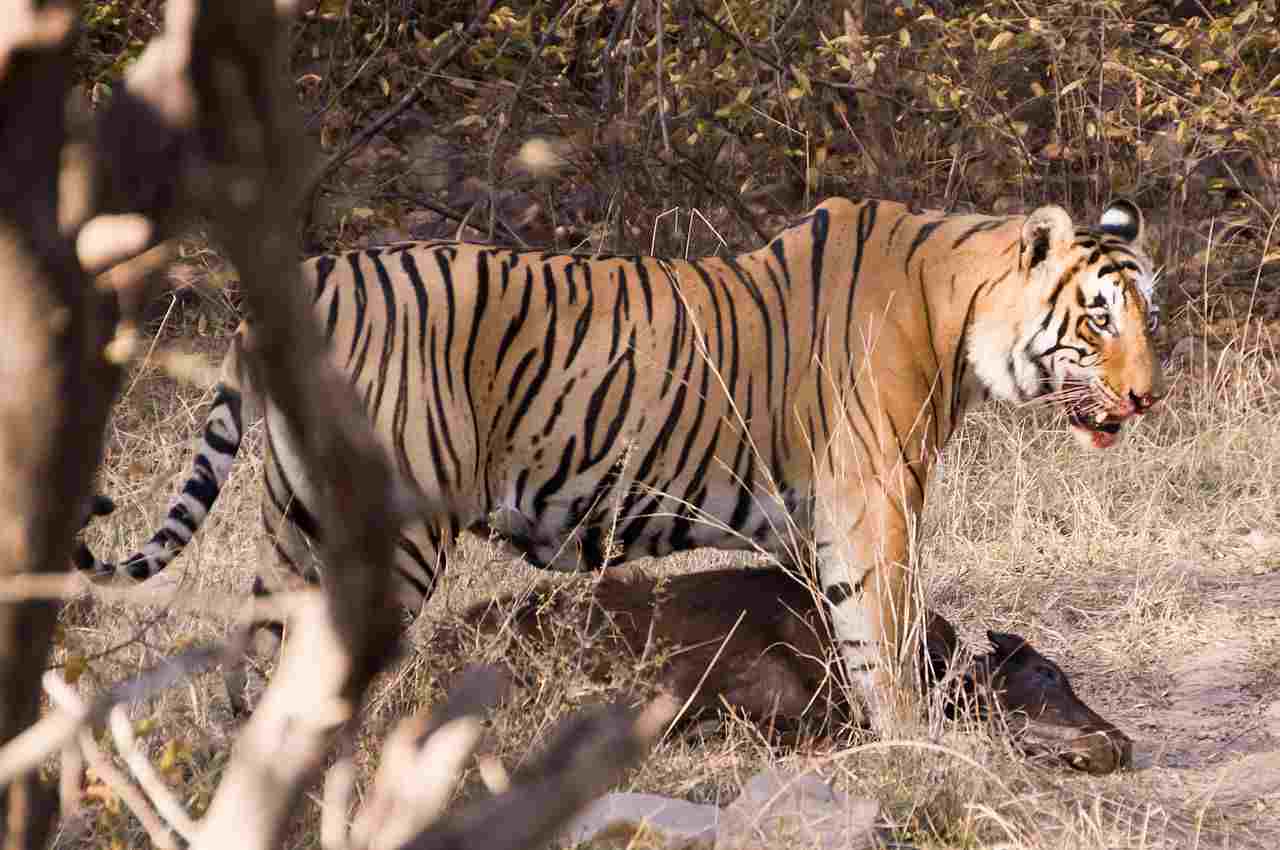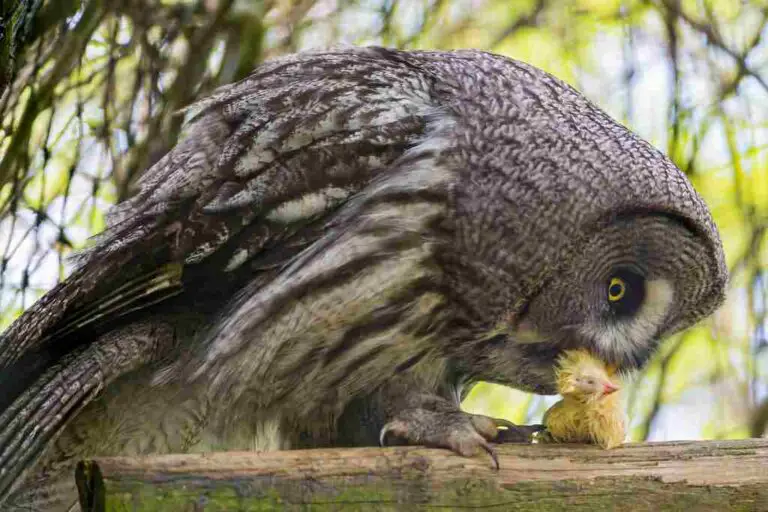Are Tigers Apex Predators? Analyzing the Trophic Status of Tigers
An adult tiger is an ultimate apex predator and does not have any natural predators, although humans occasionally hunt and kill tigers for various purposes including taxidermy and trophy collection, while some may eat the flesh of tigers as a delicacy (though this is very unusual).
However, juvenile tigers have more predators including bear, striped hyena, constrictor snakes, and crocodiles, which can prey on the tigers if left unprotected.
Other animals like elephants may pose a threat to tigers due to their imposing size and power.
Do Tigers Have Any Predators?
Juvenile tigers have potential predators like bear, striped hyena, constrictor snakes, and crocodiles. Adult tigers do not have any predators asides humans who hunt them on rare occasions.
1). Bear
Bears are potential predators of tigers, although they are not a common threat. Tigers are generally larger and more powerful than bears, making them less likely to be preyed upon. However, there have been rare instances where bears have targeted and attacked tigers, especially juvenile ones.
The bears that may prey on tigers are mostly larger species such as the brown bear and the black bear. These bears are opportunistic hunters and may target tigers when they come across them in their territories.
The conditions under which bears may prey on tigers are usually when there is a scarcity of their preferred food sources. If bears are unable to find their usual prey, such as fish or smaller mammals, they may resort to hunting tigers as an alternative food source.
It is important to note that bears are also known to scavenge on tiger carcasses. If a tiger dies due to natural causes or is killed by other predators, bears may take advantage of the opportunity to feed on the carcass.
2). Striped Hyena
The striped hyena is considered a potential predator of tigers, although instances of hyenas preying on tigers are rare. Tigers, with their size and strength, are generally not easy targets for hyenas. However, there have been documented cases where striped hyenas have targeted and attacked tigers, particularly when the tigers are vulnerable, such as cubs or injured individuals.
The striped hyena is known to be an opportunistic hunter, and the tigers it may prey on are mostly those that are weakened or unable to defend themselves effectively. In such situations, the hyenas take advantage of the tiger’s vulnerability and attempt to overpower it. However, these interactions between hyenas and tigers are infrequent and occur under specific circumstances.
The conditions under which striped hyenas may prey on tigers usually involve a scarcity of their preferred food sources. Striped hyenas primarily feed on carrion and small to medium-sized mammals. If their usual prey is scarce, such as during periods of drought or competition with other predators, hyenas may resort to hunting tigers as an alternative food source.
Additionally, striped hyenas are known to scavenge on tiger carcasses. If a tiger dies due to natural causes or is killed by other predators, hyenas may take advantage of the opportunity to feed on the carcass. This scavenging behavior helps hyenas survive during times when hunting is challenging or when food resources are limited.
The preferred food sources of striped hyenas include carrion, small mammals, birds, reptiles, and insects. They are adaptable scavengers and can survive on a wide range of food items. However, tigers are not a primary part of their diet, and they are more likely to target smaller prey that is easier to capture and consume.
3). Constrictor Snakes
Constrictor snakes are considered a potential predator of tigers, although instances of snakes preying on tigers are extremely rare. Tigers, with their agility and strength, are not easy targets for constrictor snakes. However, there have been cases where snakes have targeted and attacked tigers, particularly when the tigers are vulnerable, such as cubs or injured individuals.
The conditions under which constrictor snakes may prey on tigers usually involve a scarcity of their preferred food sources. Constrictor snakes primarily feed on small to medium-sized mammals, birds, and reptiles. If their usual prey is scarce, such as during periods of drought or competition with other predators, snakes may resort to hunting tigers as an alternative food source.
It is important to note that constrictor snakes do not actively seek out tigers as prey. Tigers are not a primary part of their diet, and they are more likely to target smaller prey that is easier to capture and consume. Additionally, constrictor snakes do not scavenge on tiger carcasses. They mostly rely on live prey for their sustenance, and are not likely to feed on carrion.
4). Crocodiles
Crocodiles are considered a potential predator of tigers, although instances of crocodiles preying on tigers are also rare. Tigers, with their size and strength, are not easy targets for crocodiles. However, instances exist where crocodiles have attacked tigers, particularly when the tigers are near bodies of water or crossing rivers.
The conditions under which crocodiles may prey on tigers usually involve a combination of factors. Tigers that venture into crocodile habitats, such as rivers or lakes, are more vulnerable to crocodile attacks. Additionally, if a tiger is injured or weakened, it becomes an easier target for a crocodile. Crocodiles are opportunistic predators and will take advantage of any opportunity to capture prey, including tigers.
While crocodiles may prey on tigers, it is important to note that tigers are not a primary part of their diet. Crocodiles primarily feed on fish, reptiles, and smaller mammals. Tigers are larger and more challenging to subdue compared to their usual prey. Crocodiles are more likely to target smaller prey that is easier to capture and consume.
Crocodiles do not scavenge on tiger carcasses. They are active hunters and rely on live prey for their sustenance. They are not likely to feed on carrion, including tiger carcasses.
5). Humans
Humans are a potential predator of tigers, although instances of humans preying on tigers are extremely rare. Tigers, with their strength and agility, are formidable creatures that are not easily subdued by humans. However, there have been historical accounts of humans hunting tigers for various reasons, including sport, trophy hunting, and illegal wildlife trade.
The conditions under which humans may prey on tigers usually involve a combination of factors. Tigers that come into close proximity to human settlements or agricultural areas are more vulnerable to human attacks. Additionally, if a tiger poses a threat to human lives or livestock, it may be targeted for elimination. In some cases, tigers may also fall victim to poaching for their valuable body parts, such as bones, skin, and organs, which are highly sought after in illegal wildlife markets.
Unlike other predators, humans do not scavenge on tiger carcasses. They are not known to rely on tiger meat for sustenance. Instead, humans primarily target tigers for their valuable body parts, which are used in traditional medicine, luxury goods, and as status symbols. This illegal trade poses a significant threat to the survival of tiger populations in the wild.
It is important to note that humans are not natural predators of tigers. Tigers are apex predators in their ecosystems and play a crucial role in maintaining the balance of the food chain. They regulate prey populations and help control herbivore numbers, which in turn affects vegetation and overall ecosystem health. The loss of tigers due to human activities can have far-reaching consequences for the entire ecosystem.
Efforts are being made to protect tigers and their habitats through conservation initiatives, stricter law enforcement, and raising awareness about the importance of preserving these magnificent creatures. Conservation organizations and governments are working together to combat poaching, reduce human-wildlife conflicts, and promote sustainable practices that benefit both tigers and local communities.

Are Tigers Predators or Prey?
Tigers are primarily predators rather than prey in their ecosystems. They are known as ambush predators, relying on their stealth and strength to take down their prey. These apex predators primarily hunt large ungulates, such as wild boar and deer. However, their diet is not limited to these animals alone. Tigers have been observed consuming a variety of other species, including monkeys, buffalo, sloth bears, leopards, and even crocodiles.
Research studies conducted on tiger prey species in the Huai Kha Khaeng Wildlife Sanctuary have provided valuable insights into their hunting habits. The main prey species identified in this area include ungulates such as bantengs, sambar, muntjac, gaur, and others. Tigers have adapted to their environments and have developed the necessary skills to successfully hunt and capture these animals.
It is important to note that tigers are not passive prey animals. They are powerful predators that play a crucial role in maintaining the balance of the food chain. By regulating prey populations, tigers help control herbivore numbers, which in turn affects vegetation and overall ecosystem health. Their presence is essential for the stability and functioning of their respective ecosystems.
Are Bengal Tigers Apex Predators?
Bengal tigers, found primarily in the Indian subcontinent, are indeed considered apex predators in their respective ecosystems. They inhabit a range of habitats, including grasslands, mangrove forests, and tropical rainforests. Bengal tigers are apex predators because they occupy the top position in the food chain and have no natural predators themselves.
These majestic creatures are known for their strength, agility, and hunting prowess. They have a diverse diet and are capable of taking down a wide range of prey species. Bengal tigers primarily feed on large ungulates such as gaur, deer, and water buffalo. However, they are opportunistic hunters and have been observed preying on smaller animals like wild boar, juvenile rhinoceros, and even reptiles like turtles and lizards.
Bengal tigers are highly adaptable predators, capable of hunting both on land and in water. They are known to ambush their prey, utilizing their powerful muscles and sharp claws to bring down their targets. Their stealth and camouflage allow them to blend seamlessly into their surroundings, making them even more effective hunters.
The success of Bengal tigers as apex predators is crucial for maintaining the balance of their ecosystems. By regulating the populations of their prey species, they help prevent overgrazing and maintain the health of vegetation. This, in turn, has a cascading effect on other organisms within the ecosystem, ensuring its overall stability.
Are Siberian Tigers Apex Predators?
Siberian tigers, also known as Amur tigers, are indeed apex predators in their respective habitats. They inhabit the vast forests of Siberia, primarily in Russia, and are the largest subspecies of tigers. Siberian tigers are apex predators because they hold the top position in the food chain and have no natural predators themselves.
These magnificent creatures have adapted to survive in the harsh and cold climates of their habitat. They have a diverse diet and primarily feed on large ungulates such as gaur, deer, and water buffalo. However, they are opportunistic hunters and have been observed preying on smaller animals like wild boar, juvenile rhinoceros, and even reptiles like turtles and lizards.
Siberian tigers are known for their immense strength and agility, which allows them to take down prey that may be larger than themselves. They are skilled stalkers and ambush their targets with precision. Their powerful muscles and sharp claws enable them to overpower their prey and deliver a swift and lethal attack.
The role of Siberian tigers as apex predators is crucial for maintaining the balance of their ecosystems. By regulating the populations of their prey species, they help prevent overgrazing and maintain the health of vegetation. This, in turn, supports the survival of other organisms within the ecosystem, ensuring its overall stability.
What are Tigers’ Prey? Overview of Potential Prey for Tigers
1). Gaur
Gaur, also known as the Indian bison, is a large and powerful bovine species that inhabits the forests and grasslands of South Asia. These majestic creatures are one of the primary prey species for tigers in their natural habitat. Tigers primarily target young gaur, but occasionally, they may also take down older individuals.
The gaur’s massive size and strength make it a formidable opponent, even for a tiger. However, tigers are skilled hunters and possess the agility and stealth necessary to successfully bring down these formidable prey. They rely on their powerful jaws and sharp claws to deliver a swift and fatal blow to the gaur, ensuring a successful hunt.
Gaur are herbivores, feeding on a variety of vegetation such as grass, leaves, and fruits. Their large size and herbivorous diet make them an attractive target for tigers, providing a substantial source of nutrition. By preying on gaur, tigers can obtain the energy and nutrients they need to survive and thrive in their environment.
The interaction between tigers and gaur is a fascinating example of predator-prey dynamics in the wild. Tigers play a crucial role in regulating gaur populations, helping to maintain a healthy balance within the ecosystem. The presence of tigers as apex predators ensures that gaur populations do not become too abundant, which could have detrimental effects on the surrounding vegetation and other species.
2). Deer
Deer are a primary prey species for tigers and play a significant role in their diet. Tigers are highly skilled hunters and have adapted their hunting strategies to successfully capture deer. With their powerful muscles and sharp claws, tigers can swiftly bring down a deer, ensuring a successful hunt.
Deer are herbivores and feed on a variety of vegetation such as grass, leaves, and fruits. Their abundance in forests and grasslands makes them an attractive target for tigers, providing a consistent source of nutrition. By preying on deer, tigers can obtain the energy and nutrients they need to survive and thrive in their environment.
The interaction between tigers and deer is a crucial aspect of the predator-prey dynamics in the wild. Tigers play a vital role in regulating deer populations, preventing them from becoming too abundant and causing overgrazing. This balance is essential for maintaining the health of the surrounding vegetation and the overall ecosystem.
In addition to their ecological significance, deer also hold cultural and symbolic importance in many societies. They are often revered as graceful and majestic creatures, embodying qualities such as agility and beauty. The presence of tigers as apex predators further enhances the significance of deer in the natural world, highlighting their role as a vital component of the food chain.
3). Water Buffalo
Water buffalo are a significant prey species for tigers, playing a crucial role in their diet. Tigers have evolved to be formidable hunters and have developed strategies to successfully capture water buffalo. With their immense strength and sharp teeth, tigers can overpower and bring down a water buffalo, ensuring a successful hunt.
Water buffalo are herbivores and primarily feed on grasses and aquatic plants. Their large size and abundance in wetland areas make them an attractive target for tigers, providing a substantial source of nutrition. By preying on water buffalo, tigers can obtain the energy and nutrients they need to thrive in their environment.
The interaction between tigers and water buffalo is a key component of the predator-prey dynamics in their habitat. Tigers play a vital role in regulating water buffalo populations, preventing them from becoming too numerous and causing overgrazing of vegetation. This balance is crucial for maintaining the health of the wetland ecosystems where water buffalo reside.
In addition to their ecological significance, water buffalo also hold cultural and economic importance in many regions. They are often domesticated for agricultural purposes and provide valuable resources such as milk, meat, and labor.

4). Wild Boar
Wild boar are another important prey species for tigers, contributing significantly to their diet. Tigers have adapted their hunting strategies to effectively capture and consume wild boar, showcasing their prowess as apex predators.
Wild boar are omnivorous animals, feeding on a variety of vegetation, insects, and small animals. Their adaptable diet and ability to thrive in different habitats make them a suitable target for tigers. With their powerful jaws and sharp claws, tigers can overpower and bring down a wild boar, ensuring a successful hunt.
The interaction between tigers and wild boar is a crucial aspect of the predator-prey dynamics in their ecosystem. Tigers play a vital role in controlling the population of wild boar, preventing overgrazing and maintaining the balance of the ecosystem. By preying on wild boar, tigers help regulate their numbers and ensure the health of the surrounding vegetation.
In addition to their ecological significance, wild boar also hold cultural and economic importance in many regions. They are hunted for their meat, which is considered a delicacy in some cultures. Wild boar hunting also provides recreational opportunities for hunters, contributing to local economies.
Understanding the relationship between tigers and wild boar is essential for conservation efforts. By protecting the habitats of both species and ensuring their coexistence, we can maintain the delicate balance of the ecosystem and preserve the biodiversity of the region.
5). Juvenile Rhinoceros
Juvenile rhinoceroses are among the prey targeted by tigers in their quest for sustenance and survival. These young rhinos, with their vulnerable stature and lack of experience, become prime targets for the apex predators prowling their territories.
Tigers possess the strength, agility, and stealth necessary to successfully hunt down and overpower juvenile rhinoceroses. Their powerful jaws and sharp claws enable them to bring down these formidable creatures, showcasing their prowess as apex predators in the animal kingdom.
The interaction between tigers and juvenile rhinoceroses is a fascinating aspect of the predator-prey dynamics in their shared habitat. Tigers play a crucial role in regulating the population of rhinoceroses, ensuring the balance of the ecosystem. By preying on juvenile rhinoceroses, tigers help prevent overpopulation and maintain the health of the surrounding vegetation.
The conservation of both tigers and rhinoceroses is of utmost importance. These magnificent creatures are both endangered species, facing numerous threats to their survival. Protecting their habitats and implementing effective conservation measures is essential to ensure their coexistence and preserve the biodiversity of the region.
Furthermore, the presence of tigers and their predation on juvenile rhinoceroses has broader implications for the ecosystem. By controlling the population of rhinoceroses, tigers indirectly contribute to the well-being of other species and maintain the delicate balance of the ecosystem.
6). Elephant Calf
Elephant calves are vulnerable targets for tigers, making them a significant prey species in the ecosystem. Tigers, being apex predators, possess the strength and agility to take down these young elephants, showcasing their hunting prowess.
The interaction between tigers and elephant calves is a complex dynamic. Tigers carefully select their targets, often choosing weak or injured individuals. This helps maintain the overall health and vitality of the elephant population, as weaker individuals are more likely to succumb to disease or other natural causes.
Tigers employ their stealth and patience to stalk their prey, waiting for the opportune moment to strike. Once they pounce, their powerful jaws and sharp claws enable them to bring down an elephant calf swiftly. This not only provides sustenance for the tiger but also helps regulate the population of elephants, preventing overpopulation and ensuring the balance of the ecosystem.
The predation of tigers on elephant calves has broader implications for the ecosystem. By controlling the population of elephants, tigers indirectly contribute to the well-being of other species and maintain the delicate balance of the habitat. Additionally, the carcasses of elephant calves provide a vital source of food for scavengers, further supporting the intricate web of life in the ecosystem.
Conservation efforts aimed at protecting both tigers and elephants are crucial. These magnificent creatures are facing numerous threats, including habitat loss and poaching. Preserving their habitats and implementing effective conservation measures is essential to ensure their survival and the preservation of biodiversity.
7). Turtle
Turtles are among the prey species targeted by tigers in their quest for sustenance. These reptiles, with their slow and steady movements, may seem like an easy target for the agile and powerful predators. Tigers utilize their stealth and patience to stalk turtles, waiting for the perfect opportunity to strike. With a swift pounce, their sharp claws and powerful jaws enable them to capture and consume these shelled creatures.
The predation of turtles by tigers serves a crucial role in maintaining the balance of the ecosystem. By controlling the population of turtles, tigers indirectly contribute to the well-being of other species that rely on these reptiles for survival. Additionally, the carcasses of turtles provide a valuable source of food for scavengers, further supporting the intricate web of life in the habitat.
Conservation efforts aimed at protecting both tigers and turtles are of utmost importance. These magnificent creatures face numerous threats, including habitat loss and illegal wildlife trade. Preserving their habitats and implementing effective conservation measures is essential to ensure their survival and the preservation of biodiversity.
8). Lizard
Lizards are another prey species that fall victim to the hunting prowess of tigers. These small reptiles, with their quick movements and ability to blend into their surroundings, may seem like a challenging target for the big cats. However, tigers have developed remarkable hunting strategies to capture lizards and add them to their menu.
With their keen eyesight and acute sense of hearing, tigers can detect the slightest movement or rustle of leaves that betray the presence of a lizard. They patiently stalk their prey, using their stealth and agility to get within striking distance. In a lightning-fast moment, the tiger pounces, using its sharp claws and powerful jaws to secure its meal.
The predation of lizards by tigers plays a vital role in the ecosystem. Lizards are known to be carriers of parasites and disease, and by controlling their population, tigers help maintain a healthier environment for other species. Additionally, the consumption of lizards provides tigers with essential nutrients and sustains their energy levels, enabling them to continue their role as apex predators.
Conservation efforts aimed at protecting both tigers and lizards are crucial. Tigers face numerous threats, including habitat loss and poaching, which directly impact their ability to hunt and survive. Preserving the habitats of both tigers and lizards is essential to maintain the delicate balance of the ecosystem and ensure the survival of these remarkable creatures.
9). Snake
Snakes are a common prey of tigers, showcasing the versatility and adaptability of these apex predators. Tigers have honed their hunting skills to capture and consume snakes, which provide them with a valuable source of nutrition and sustenance.
With their acute senses, tigers can detect the presence of snakes through their scent and vibrations. They patiently stalk their slithering prey, carefully calculating their movements to ensure a successful ambush. Once within striking distance, the tiger uses its lightning-fast reflexes to deliver a swift and deadly blow, overpowering the snake with its powerful jaws and sharp claws.
The predation of snakes by tigers serves an important ecological role. Snakes are known to control rodent populations, which can become pests and cause damage to crops. By keeping the snake population in check, tigers help maintain a balanced ecosystem and prevent the proliferation of these pests. Additionally, snakes provide tigers with essential nutrients, such as proteins and vitamins, contributing to their overall health and vitality.
Conservation efforts aimed at protecting both tigers and snakes are crucial for the preservation of these species. Tigers face numerous threats, including habitat loss and illegal wildlife trade, which directly impact their ability to hunt and survive. Preserving the habitats of both tigers and snakes is essential to ensure the continued existence of these fascinating creatures and the ecological balance they contribute to.
10). Fish
Fish are a common prey of tigers, showcasing their adaptability as apex predators. Tigers have evolved their hunting techniques to capture and consume fish, which provide them with a rich source of nutrients and sustenance.
With their keen eyesight and acute sense of hearing, tigers are able to spot fish swimming in the water. They patiently wait at the water’s edge, observing the movements of their prey. When the time is right, the tiger swiftly dives into the water, using its powerful limbs to propel itself towards the fish. With a quick swipe of its paw, the tiger snatches the fish out of the water, securing its meal.
The predation of fish by tigers plays a vital role in maintaining the balance of aquatic ecosystems. Fish populations can grow rapidly and deplete resources, leading to ecological imbalances. By preying on fish, tigers help regulate their numbers, ensuring the survival of other species in the ecosystem. Additionally, fish provide tigers with essential fatty acids and omega-3, contributing to their overall health and well-being.
Conservation efforts focused on protecting both tigers and fish are crucial for the preservation of these species. Tigers face numerous threats, including habitat destruction and poaching, which directly impact their ability to hunt and survive. Preserving the habitats of both tigers and fish is essential to maintain the delicate balance of aquatic ecosystems and ensure the continued existence of these magnificent creatures.
11). Frog
Frogs, along with other amphibians, are a part of the diet of tigers, highlighting their role as apex predators in diverse ecosystems. Tigers have adapted their hunting strategies to capture and consume frogs, which provide them with essential nutrients and contribute to their overall survival.
With their exceptional agility and stealth, tigers are able to locate and catch frogs in various habitats. They patiently wait near water bodies or in dense vegetation, using their acute senses to detect the movements and sounds of their prey. When the opportunity arises, the tiger pounces swiftly, using its powerful jaws to grasp the frog and secure its meal.
The predation of frogs by tigers serves an important ecological function. Frogs play a crucial role in maintaining the balance of ecosystems by controlling insect populations and serving as indicators of environmental health. By preying on frogs, tigers help regulate their numbers, ensuring the stability of these ecosystems.
12). Termites
Termites, along with other insects like ants, beetles, and grasshoppers, are a prey of tigers. These small creatures play a significant role in the diet of tigers, providing them with a source of protein and essential nutrients. Tigers have adapted their hunting techniques to capture and consume termites efficiently.
Termites are often found in large colonies, constructing intricate mounds and tunnels. Tigers, with their acute sense of smell, can detect the presence of termites from a distance. They use their powerful jaws and sharp claws to dig into termite mounds, exposing the insects and devouring them. This hunting strategy allows tigers to obtain a substantial amount of food in a short period.
The inclusion of termites in the diet of tigers is crucial for their survival and overall health. These insects are rich in protein, which is essential for the growth and maintenance of the tiger’s muscular system. Additionally, termites provide tigers with a source of energy, helping them sustain their high metabolic rate.
The predation of termites by tigers also has ecological implications. Termites are known for their ability to break down dead plant material and recycle nutrients back into the ecosystem. By consuming termites, tigers indirectly contribute to nutrient cycling and the overall health of their habitat.
Conclusion
* In conclusion, this article has explored the trophic status of tigers and analyzed whether they can be considered apex predators. We have examined the predators of tigers, their prey, and their role in the ecosystem.
* Tigers, despite being powerful and formidable hunters, do have predators of their own. Bears, striped hyenas, constrictor snakes, crocodiles, and humans pose threats to tigers in various ways. These predators can compete with tigers for resources, prey upon them, or even pose a danger to their survival through habitat destruction and poaching.
* On the other hand, tigers also play the role of predators in their ecosystems. They are known to be opportunistic hunters and have a diverse range of prey. Gaur, deer, water buffalo, wild boar, juvenile rhinoceros, elephant calf, turtle, lizard, snake, fish, frog, and even termites make up the diet of tigers.
* While tigers are undoubtedly predators, the question of whether they are apex predators requires further examination. Apex predators are those that have no natural predators themselves and play a crucial role in regulating the population of other species in their ecosystems.
* Bengal tigers, found primarily in the Indian subcontinent, are considered apex predators in their habitats. They are at the top of the food chain and have a significant impact on the population dynamics of their prey species. The presence of Bengal tigers helps maintain the balance of the ecosystem by controlling the numbers of herbivores and preventing overgrazing.
* Siberian tigers, also known as Amur tigers, inhabit the forests of Russia and parts of China. While they are powerful predators, their status as apex predators is more debatable. The Siberian tiger’s range overlaps with that of the brown bear, which can pose a threat to the tiger and compete for resources. However, the Siberian tiger’s large size and hunting prowess still make it a formidable predator in its environment.
* Tigers’ prey species, such as gaur, deer, and water buffalo, are essential for their survival. These large herbivores provide tigers with the necessary energy and nutrients to thrive. The predation of these species by tigers helps regulate their populations and prevents overgrazing, which can have detrimental effects on the ecosystem.
* Therefore, tigers are indeed predators, but their status as apex predators varies depending on the specific tiger subspecies and the ecosystems they inhabit. Bengal tigers can be considered apex predators due to their significant impact on their prey populations and the overall balance of their habitats. Siberian tigers, while being the largest tiger species, sometimes face competition from other large predators and may not hold the same ultimate-apex predator status. Nonetheless, tigers play a crucial role in maintaining the health and balance of their ecosystems through their hunting behaviors and interactions with their prey and predators.
FAQs
1. What is The Tiger’s Biggest Enemy?
The tiger’s biggest enemy is humans. Human activities such as poaching, habitat destruction, and illegal wildlife trade pose significant threats to the survival of tigers in the wild. Poaching for their body parts, particularly their bones and skin, is driven by the demand for traditional medicine and luxury products.
Habitat loss due to deforestation and human encroachment further exacerbates the problem. Conservation efforts and stricter law enforcement are crucial in protecting tigers from these threats. By addressing the root causes and raising awareness about the importance of tiger conservation, we can help ensure a future where tigers can thrive in their natural habitats.
2. Are Tigers the Ultimate Predator?
Tigers are often considered the ultimate predator in their habitats. With their powerful build, sharp claws, and strong jaws, they are formidable hunters. Tigers are skilled at stalking and ambushing their prey, using their camouflage to blend into the surroundings before launching a surprise attack. Their agility and speed allow them to chase down and capture fast-moving prey, such as deer and wild boar. Tigers have been known to take down animals much larger than themselves, including buffalo and even adult elephants.
However, it’s important to note that the term “ultimate predator” can be subjective and dependent on various factors. While tigers are apex predators in their ecosystems, there are other predators that may have different hunting strategies or occupy different niches within the food chain. Each predator plays a vital role in maintaining the balance of the ecosystem.
3. Are Tigers Apex Predators in India?
Yes, tigers are apex predators in the forests of India. With their strength, agility, and hunting skills, they dominate the food chain in their habitats. Tigers in India primarily prey on large ungulates such as deer, wild boar, and buffalo. They are known to take down animals much larger than themselves, showcasing their status as top predators.
In the Indian ecosystem, tigers play a crucial role in maintaining the balance of the food chain. Their presence helps control the population of herbivores, preventing overgrazing and ensuring the health of the ecosystem as a whole. Tigers are highly adapted to their environment and have evolved to be efficient hunters, making them apex predators in India’s forests.
4. What are Tigers’ Predators?
Tigers, being apex predators, have few natural predators in the wild. However, they do face threats from humans, who hunt them for their skin, bones, and other body parts. Poaching remains a significant danger to tiger populations, leading to their decline in many areas.
While adult tigers are formidable and can defend themselves against most predators, juvenile tigers are more vulnerable. They may face predatory threats from other large carnivores such as crocodiles, bears, and even other tigers. These interactions occur when territories overlap or during disputes over resources.
Despite these occasional threats, tigers’ biggest predator remains humans. Conservation efforts and stricter laws are crucial to protect these majestic creatures and ensure their survival in the wild.
5. Who Eats Tiger in the Food Chain?
In the food chain, tigers are apex predators, meaning they have no natural predators. They are at the top of the food chain and play a crucial role in maintaining the balance of their ecosystems. Tigers primarily prey on large ungulates such as deer, wild boar, and buffalo. However, in rare cases, when a tiger is injured, sick, or old, it may become vulnerable to other predators.
One potential predator of tigers is the Asiatic lion. Although tigers and lions generally inhabit different regions, their territories can overlap, leading to occasional conflicts. In such cases, lions may target weakened or injured tigers as potential prey.
6. Do Tigers Have Predators?
Naturally, tigers do not have any predators. As apex predators, they sit at the top of the food chain and have no natural enemies. Tigers are highly skilled hunters and possess the strength, agility, and stealth to take down large prey. They primarily target ungulates such as deer, wild boar, and buffalo.
However, despite their position as apex predators, tigers can still face threats from humans. Illegal poaching and habitat destruction have significantly impacted tiger populations worldwide. Tigers are hunted for their valuable body parts, which are used in traditional medicine and for their skins. Additionally, deforestation and human encroachment on tiger habitats have led to a decline in their numbers.
It is crucial to protect tigers and their habitats to ensure their survival. Conservation efforts, such as establishing protected areas and implementing strict anti-poaching measures, are essential for safeguarding these magnificent creatures. By addressing the human-induced threats, we can help maintain the delicate balance of ecosystems and ensure the continued existence of tigers in the wild.

7. What do Tigers Eat?
Tigers are carnivorous predators and their diet primarily consists of large ungulates such as deer, wild boar, and buffalo. These animals serve as their main source of food and provide the necessary nutrients for their survival. Tigers are skilled hunters and rely on their strength, agility, and stealth to successfully capture their prey.
In addition to ungulates, tigers may also consume smaller animals such as monkeys, birds, and reptiles. These smaller prey items supplement their diet and provide variety in their meals. Tigers are opportunistic hunters and will take advantage of any available food source in their habitat.
It is important to note that the diet of a tiger can vary depending on its geographic location and the availability of prey species. For example, tigers in the Sundarbans mangrove forest of India and Bangladesh have been known to prey on fish and even attack humans in rare cases.
8. Are Lions and Tigers Predators?
Yes, lions and tigers are both predators, but they inhabit different ecoregions. Lions are primarily found in Africa, while tigers are native to Asia. These majestic big cats share similar characteristics as apex predators in their respective habitats. They are both powerful hunters with sharp claws and strong jaws, capable of taking down large prey.
In the African savannah, lions are known for their cooperative hunting behavior, forming prides to increase their chances of success. They primarily target herbivores such as zebras, wildebeests, and antelopes. On the other hand, tigers are solitary hunters and adapt to a variety of habitats, including forests and grasslands. Their prey includes deer, wild boar, and buffalo.
9. What is the Largest Prey of a Tiger?
The largest prey of a tiger includes adult gaur and wild water buffalo, each of which can weigh over 1,100 kg. Tigers are known for their strength and agility, allowing them to take down such formidable prey. These massive herbivores provide a substantial amount of food for the tiger, ensuring its survival in the wild.
Tigers are highly skilled hunters and have developed unique strategies to capture their prey. They rely on their stealth and camouflage to get close to their target before launching a surprise attack. With their powerful jaws and sharp claws, tigers can quickly overpower their prey, delivering a fatal bite to the neck or throat.
The ability of tigers to bring down large prey is a testament to their status as apex predators. They play a crucial role in maintaining the balance of ecosystems by controlling the population of herbivores. Without tigers, the numbers of gaur and wild water buffalo could increase uncontrollably, leading to overgrazing and habitat degradation.





